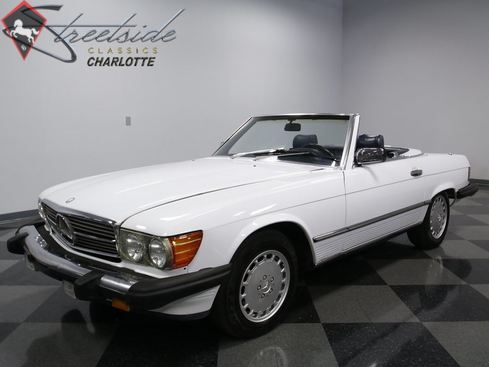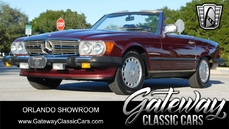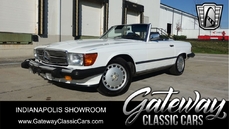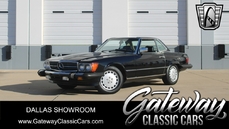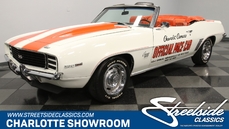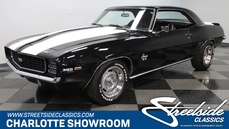Mercedes-Benz 560SL w107 5.6L V8 1986
General description :
83K MI, ORIG 5.6L, AUTO, LOADED, TWO TOPS, RUNS WELL, GOOD PAINT, NICE INT, FUN!
With a great color combo, precision sheetmetal, and timeless elegance, this 1986 Mercedes-Benz 560SL proves that a turnkey classic can provide the good life at an affordable price.
The 560SL is highly desirable because it's an entire wish list in one car. These are elegant, powerful, comfortable, and nimble classics. The now legendary R107 model designation is iconic because it represents an era when very few companies could build a convertible without worrying about safety regulations. Mercedes built their cars so robustly that the R107 exceeded these standards, and they did it elegantly without an unsightly roll bar. It was the go-to driver for celebrities, dignitaries, and the wealthy because the sleek lines hid a full size interior, and usable trunk, that was perfect for any road trip. The factory-correct Arctic White paint has timeless desirability – especially when the color still retains its quality luster, and the panels have been carefully maintained to retain their German-precision feeling. Also, this one carries the distinction of the more aerodynamic factory alloy wheels that only came on the later R107 cars.
One of the best complements to the exterior paint is the interior color. Whether people see you on sunny days with the optional blue leather, or even when the taut blue fabric top is up, both of these highlight the kind of corresponding colors that are still being utilized by the finest carmakers today. You even get the removable hardtop that is color-keyed to make this roadster look like an elegant coupe. Beyond just the perfect hues, this Mercedes is desirable because there's plenty of evidence of a pampered life. The carpets, seats, and wood grain center console basically show no signs of sun damage – a true sign that this droptop has only been handled with care. The 560SL was one of the most expensive cars Mercedes offered during its reign, so the features list is quite long. It includes conveniences such as power windows, power steering, cruise control, and the original Becker AM/FM cassette stereo. There are even provisions for air conditioning, and a removable rear windscreen. Because this was built 1986, there are also more modern safety features than most R107s, such as anti-lock brakes, a third brake light, and a driver's air bag.
Under the hood is the original numbers-matching 5.6-liter V8. The 560SL was really the car to have from the R107 period because it combined a powerful motor with a reputation for bulletproof durability. But besides just averaging 2,700 miles annually, you can tell by the cleanliness of the engine bay that this has always been a cherished luxury machine. So there's nothing stopping you from hitting the road for a long weekend, and when you do, this luxury convertible strikes the perfect balance between nimble machine and all-day cruiser. That's thanks to a specially engineered fully independent suspension, four-speed automatic transmission with overdrive, and four-wheel disc brakes. They all work in harmony to provide a true luxury experience that has been the envy of other car makers.
This timeless classic proves its worth in the full file that comes with it, which includes the full package of owner's booklets and service manuals. Turnkey high society is rarely this affordable, so it's time to grab the brass ring while it's still within reach. Call now!!
Features : AM/FM Radio, Defrost, Numbers Matching, Manual Convertible Top, Removable Hard Top, Air Conditioning, Heat, Leather Seats, Cruise Control, Fuel Injection, Power Brakes, Power Windows, Driver Airbag, Seatbelts, Anti-Lock Brakes, Four Wheel Disc Brakes
http://www.streetsideclassics.com/vehicles/3926-cha/1986-mercedes-benz-560sl
1986 Mercedes-Benz 560SL w107 5.6L V8 is listed sold on ClassicDigest in Charlotte by Streetside Classics for $14995.
Car Facts
Car type : Car Make : Mercedes-Benz Model : 560SL w107 Model Version : 5.6L V8 Engine size : 0.0 Model Year : 1986 Sub type : Convertible Location : Charlotte
Sold
Seller Information
Sold
People who viewed this Mercedes-Benz 560SL w107 also viewed similar Mercedes-Benz listed at ClassicDigest
Other cars listed for sale by this dealer
About Mercedes-Benz
In the annals of automotive history, the journey of Mercedes-Benz is a tale that unfolds with the ingenuity of its founding pioneers. In the year 1886, Karl Benz crafted the Benz Patent Motorwagen, a creation that would go down in history as the world's inaugural automobile. Unbeknownst to him, this moment marked the genesis of what would evolve into the most illustrious premium car manufacturer globally. The financial underpinning of this pioneering venture, interestingly, was provided by Karl Benz's wife, Bertha Benz, demonstrating a remarkable partnership that would set the tone for Mercedes-Benz's legacy.A parallel narrative emerged not far away, as Daimler-Motoren-Gesellschaft, founded by Gottlieb Daimler and Wilhelm Maybach, entered the scene. In 1901, they unveiled their automobile under the now-famous moniker "Mercedes," meaning "godsend" in Spanish. This name was bestowed upon the car at the behest of Emil Jellinek's daughter, the distributor for Daimler-Motoren-Gesellschaft. The wheels of innovation were set in motion.
Fast forward to 1926, a pivotal year that witnessed the merger of Daimler with Benz & Cie., culminating in the birth of Daimler-Benz. The amalgamation saw the adoption of "Mercedes-Benz" as the distinguished trademark for their automobiles, fusing the legacies of two visionary entities into one.
Contrary to perceptions of conservatism, the trajectory of Daimler-Benz unfolds as a chronicle of industry firsts. From the introduction of the honeycomb radiator to the float carburetor, and the pioneering implementation of four-wheel brakes in 1924, Daimler-Benz consistently pushed the boundaries of automotive innovation. The diesel-powered Mercedes-Benz 260 D in 1936 marked the inception of diesel engines in passenger cars. The iconic Mercedes-Benz 300SL Gullwing made history as the first car with direct fuel injection, albeit the Gutbrod's tiny 2-stroke engine can claim precedence.
Safety innovations became a hallmark, with Béla Barényi's patented safety cell design in the "Ponton"-models in 1951, featuring front and rear crumple zones. The W116 450SEL 6.9 saw the introduction of the Anti-Lock Brake system (ABS), another pioneering safety feature. From the first production airbags and beyond, the legacy of "firsts" continued to be etched into the fabric of Daimler-Benz.
Over its centennial journey, Mercedes-Benz has not merely produced cars but has sculpted automotive icons. The SSKL, 710 SSK Trossi Roadster, 770K Grosser, 540K Spezial Roadster, 300SL Gullwing, w100 600 Pullman, w111 280SE 3.5 Flachkühler, w113 230SL Pagoda, w109 300 SEL 6.3, and w201 2.3-16 Cosworth stand testament to the brand's commitment to engineering excellence.
The roaring Silver Arrows, or "Silberpfeile," including the W 25, W 125, W154, W165, and W196, created a legacy of dominance on the racetrack. These machines were not merely cars; they were expressions of precision, speed, and an indomitable spirit that left their competitors in the dust.
As Mercedes-Benz marches into the future, it does so not just as an automaker but as a custodian of a legacy, a torchbearer of innovation, and a beacon of automotive excellence. The road ahead is sure to witness the continued fusion of cutting-edge technology, timeless design, and an unwavering commitment to setting new standards in the world of automobiles.
One luminary figure who left an indelible mark was Béla Barényi, often heralded as the "father of passive safety" for his pioneering work in safety engineering. His patented safety cell design, featuring front and rear crumple zones, became a hallmark of Mercedes-Benz's commitment to occupant safety, setting new standards that reverberated throughout the automotive world.
Moving through the chronicles, the collaborative genius of Wilhelm Maybach, alongside Gottlieb Daimler, laid the foundation for Daimler-Motoren-Gesellschaft. Their innovations not only birthed the first Mercedes but established a culture of relentless pursuit of technological excellence that remains integral to Mercedes-Benz's DNA.
In the post-merger era of 1926, Ferdinand Porsche emerged as a prominent figure within Mercedes-Benz. His work on the Mercedes-Benz S-Type, a supercharged race car, garnered acclaim and set the stage for a legacy that extended far beyond the marque. Porsche's impact would later extend to his eponymous company, but his influence at Mercedes-Benz during those formative years was pivotal.
As the 20th century progressed, the legendary Rudolf Uhlenhaut emerged as a key figure. Uhlenhaut, an accomplished engineer and the driving force behind the iconic Silver Arrows, played a crucial role in Mercedes-Benz's dominance in motorsports. His engineering prowess and attention to detail were instrumental in creating some of the most formidable racing cars of the era.
In the latter half of the century, figures like Bruno Sacco, the head of design at Mercedes-Benz from 1975 to 1999, left an indelible imprint on the brand's aesthetic identity. Sacco's design philosophy, characterized by clean lines and timeless elegance, shaped iconic models like the W126 S-Class and the W201 190E, solidifying Mercedes-Benz's reputation for luxury and sophistication.
The narrative would be incomplete without acknowledging the contributions of engineers like Hans Scherenberg, whose leadership in the 1970s ushered in a new era of technological innovation at Mercedes-Benz. Scherenberg's tenure saw the development of groundbreaking technologies, including the Anti-Lock Brake system (ABS) and the introduction of airbags in production cars.
